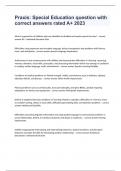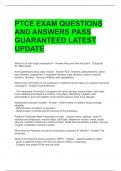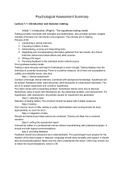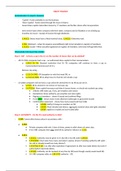Table of Contents
Week 4 ................................................................................................................................................................... 2
Readings for week 4........................................................................................................................................... 2
Parker, Wall, and Cordery (2001) – Future work design research and practice: Towards an elaborated model of
work design ............................................................................................................................................................ 2
Humphrey, Nahrgang, and Morgeson (2007) – Integrating motivational, social, and contextual work design
features: A meta-analytic summary and theoretical extension of the work design literature .............................. 4
Oldham and Fried (2016) – Job design research and theory: Past, present and future ........................................ 7
Van den Heuvel, Demerouti, and Peeters (2015) – The job crafting intervention: Effects on job resources, self-
efficacy, and affective well-being......................................................................................................................... 11
Lecture 5 .......................................................................................................................................................... 12
Week 6 ................................................................................................................................................................. 13
Readings for week 6......................................................................................................................................... 13
Houdmont & Leka (2010) – Chapter 2: Work-related stress: A theoretical perspective (by Cox and Griffiths) .. 13
Houdmont, Leka, & Sinclair (2012) – Chapter 14: Work, stress and health behaviours (by Payne, Kinman, &
Jones) ................................................................................................................................................................... 16
Peter et al. (2002) – Psychological work environment and myocardial infarction: improving risk estimation by
combining two complementary job stress models in the SHEEP study. .............................................................. 17
Torrente et al. (2017) – The effects of relaxation exercises and park walks during workplace lunch breaks on
physiological recovery.......................................................................................................................................... 18
Week 7 ................................................................................................................................................................. 19
Readings for week 7......................................................................................................................................... 19
Bakker, Demerouti, & Sanz-Vergel (2014) – Burnout and work engagement: The JD-R approach ..................... 19
Hakanen and Schaufeli (2012) – Do burnout and work engagement predict depressive symptoms and life
satisfaction? A three-wave seven-year prospective study................................................................................... 22
Schaufeli and Taris (2014) – A critical review of the job demands-resources model: Implications for improving
work and health ................................................................................................................................................... 23
Swider and Zimmerman (2010) – A meta-analytic path model of personality, job burnout, and work outcomes
............................................................................................................................................................................. 24
Xanthopoulou, Bakker, & Fischbach (2013) – Work engagement among employees facing emotional demands:
The role of personal resources ............................................................................................................................ 26
Week 8 ................................................................................................................................................................. 27
Readings for week 8......................................................................................................................................... 27
Barber and Santuzzi (2015) – Please responds ASAP: Workplace telepressure and employee recovery ............ 27
Demerouti, Derks, Ten Brummelhuis, & Bakker (2014) – New ways of working: Impact on working conditions,
work-family balance, and wellbeing .................................................................................................................... 29
Spieler, Scheibe, & Stamov Rossnagel (2016) – Keeping work and private life-apart: Age-related differences in
managing the work-nonwork interface ............................................................................................................... 31
Van Laethem, van Vianen, & Derks (2018) – Daily fluctuations in smartphone use, psychological detachment,
and work engagement: The role of workplace telepressure ............................................................................... 33
Week 9 ................................................................................................................................................................. 34
Readings for week 9......................................................................................................................................... 34
Geurts, Beckers, & Tucker (2013) – Recovery from demanding work hours ....................................................... 34
Taris et al. (2011) – Investigating the associations among overtime work, health behaviours, and health: A
longitudinal study among full-time employees ................................................................................................... 36
Taris, Schaufeli, & Shimazu (2010) – The push and pull of work: The differences between workaholism and
work engagement ................................................................................................................................................ 36
Wojdylo et al. (2013) – Work craving: A conceptualisation and measurement .................................................. 38
Blue = concept
Orange = lecture
Purple = note
1
, Week 4
Readings for week 4
Parker, Wall, and Cordery (2001) – Future work design research and practice:
Towards an elaborated model of work design
Introduction
The purpose of this research is to identify key issues for work design research and practice,
especially in relation to common jobs today and future jobs.
A backward glance
Approaches to work design can be traced back to a few centuries ago where it was thought that
jobs needed to be simplified. However, this job simplification was found to be boring, tiring,
and even potentially damaging to mental health. So, they started practical and atheoretical
solutions as job rotation and job enlargement. Contributions to this idea of job enrichment
were thanks to several theories:
• Herzberg’s two-factor theory → this theory states that fulfilment of hygiene factors are
meant to remove dissatisfaction, whereas fulfilment of motivator factors are meant to
increase satisfaction. In other words, job enrichment was needed as a motivator to
increase satisfaction. Note: this theory hasn’t received much empirical support but was
the first one that addressed the importance of
job enrichment.
• Job characteristics model (JCM) → this
model proposes five core job characteristics:
skill variety, task identity, task significance,
autonomy, and feedback. They influence
three mediational processes: experienced
meaningfulness, experienced responsibility,
and knowledge of results. Ultimately, the job
characteristics affect job satisfaction, work
motivation, performance, and reduced
turnover. Furthermore, growth need strength
(the desire for challenge and personal
development) would be a moderator in this
model. Note: so far most empirical support
has been for the direct relationship
between the core job characteristics
and job satisfaction and work
motivation. The rest of the
relationships still needs more
evidence.
• Sociotechnical systems (STS) →
this theory focused more on group
rather than individual work design.
It was the first that gave the idea of autonomous
work groups (also called self-managing / self-
directing teams). Note: because this theory lacks
specificity it is rather difficult to assess the relation
to its outcomes. Nevertheless, there has been
support for autonomous workgroups in terms of
motivation and well-being
This is an approach that recognizes the interaction
between people and technology, particularly in the
2
, workplace. It’s about designing workplaces in such a way that both people and
technology coexist in harmony.
Towards an elaborated model of work design
Antecedents → These factors can be internal
(e.g. style of management, technology within
the organisation, strategy, etc.), external
(e.g. uncertainty of the environment,
customer demands, cultural norms, etc.), or
individual (e.g. proactivity, self-efficacy,
personal values, personal ability, etc.).
Work characteristics → in the modern work
environment, task variety and job
autonomy seem to be important. Equally important is
feedback, especially since the emergence of electronic
performance monitoring (EPM) systems. Some
researchers state it benefits employees because these
systems provide accurate, fair, and timely feedback.
However, other researchers state it lacks privacy and
increases workloads, such that it can be stressful.
Nevertheless, more research is needed on the effects of
EPM systems.
Next to these traditional work characteristics, new
characteristics emerged thanks to the modern environment:
• Opportunity for skill acquisition → since employees move jobs more frequently.
• Role conflict → employees are expected to fulfil multiple roles.
• Home-work conflict → since there are more women in the workplace and employees
are able to work from home.
• Cognitive characteristics of work → since there is a shift from a production industry to
a service industry, routine work becomes less likely and this brings two new cognitive
demands with it: 1) attentional demands and 2) problem-solving demands (more
important in the service industry).
• Emotional demands of work → the requirement for employees to manage their
emotional expression in return for their payment (e.g. keep being friendly and polite to
customers who are angry with you).
• Group-level work characteristics → this includes interdependence, team cohesion,
group norms, and shared knowledge structures.
What is the added value of these new characteristics?
We can account for contextual aspects and individual characteristics which are important for
the job and the job design, as well as the demands which in some way align with the JD-R
model. So what it comes down to: work is different, relationships between employees and
employers are different. We have to look at different aspects of work if we want employees to
remain/be motivated.
Outcomes → next to the traditional outcomes, such as job satisfaction, motivation, attendance,
and performance, there are some aspects that are still overlooked. Concerning performance,
the focus is often on quantitative or qualitative performance but there is more:
• Contextual performance → helping colleagues
• Proactive performance → the use of initiative to, for example, improve internal
work processes.
3
, Other outcomes that are often overlooked include: safety (especially in production
companies), knowledge sharing, lateral integration, and collaborative decision-making.
Mechanisms linking work characteristics to outcomes → according to this article, there are four
key mechanisms that explain the process of work characteristics’ effect on outcomes:
• Motivational factors → as proposed by the JCM.
• Quick response → giving employees responsibility for tasks that are otherwise
been done by support staff means that these employees can deal with disruptive
events immediately without having to contact other people first.
• Employee learning and development
• Group interaction processes
Contingencies affecting the link between work characteristics and outcomes → apart from the
originally proposes moderator – growth need strength – other moderators have been
introduced:
• Technical interdependence → the extent to which employees need to interact in order
to get the work done. If technical interdependence is high, work should be designed at
the group level. If technical interdependence is low, work should be designed at the
individual level.
• Operational uncertainty → the greater the uncertainty (lack of clarity about how to do
the work, variability in resources, unreliability of technology, etc.), the more appropriate
it is that employees are involved in the work design process.
• Process of implementing work redesign
• The organisation’s readiness for work redesign
• The history of change within the organisation
• Job security of employees
• Individual contingencies → such as proactive personality.
Humphrey, Nahrgang, and Morgeson (2007) – Integrating motivational, social,
and contextual work design features: A meta-analytic summary and theoretical
extension of the work design literature
Introduction
One of the main problems of work design to
maximize efficiency was that it resulted in
decreased employee satisfaction, and
increased turnover and absenteeism. So
motivational theories were developed to
deal with these factors. However, the use of
motivational theories in work design also
has its limitations:
1) It was mainly focused on a limited set of
motivational work features (e.g. skill
variety, autonomy) while ignoring social
and contextual aspects.
2) Due to the success of the motivational approach, there is a decrease in research on work
design, while this is still a topic that remains unsolved and needs further attention.
Therefore, the purpose of this research is to provide a meta-analytic review of the work design
literature, including attributes of the task, job, and social and organizational environment.
Testing and extending work design theory
The expanded work design model is displayed below:
4





